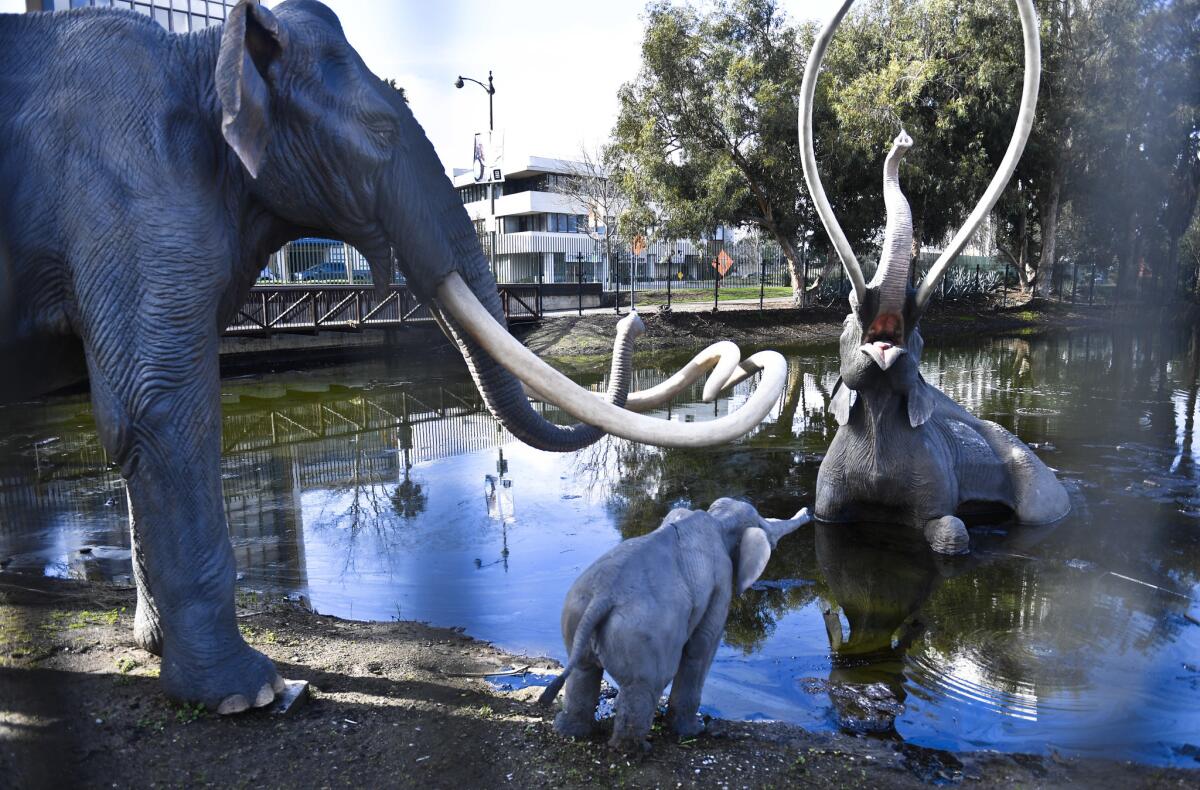The La Brea Tar Pits are getting a makeover. Here’s why

The La Brea Tar Pits, formed some 38,000 years ago and excavated in 1913, are getting a fresh new look. Or, at least, the land surrounding the pits is being rethought.
On Thursday afternoon, officials from the Natural History Museum of Los Angeles County (NHMLAC), the entity that manages the site, announced the selection of three architectural firms that will develop separate proposals for a new master plan for the 12-acre site, which includes the tar pits, the George C. Page Museum and surrounding parkland — home to the iconic Los Angeles sight of a mammoth clinging to life along the edge of a tar lake.
The announcement took place at a daylong “ideas incubator” of scientists, educators, artists, designers and museum professionals, who had been brought together to kick-start discussions about the site’s future.
Any new plan is intended to consider the entirety of the site — the land north and east of the neighboring Los Angeles County Museum of Art — and make recommendations for maintenance and redesign.

ALSO: In a new redesign LACMA experiences shrinkage — and shapeshifts yet again »
The three architectural firms in the running to devise the new plan are Dorte Mandrup, a Danish firm with experience working on UNESCO World Heritage Sites; New York’s Weiss/Manfredi, the team that designed Seattle’s Olympic Sculpture Park, and Diller Scofidio + Renfro, the firm, also based in New York, that worked on the redevelopment of Manhattan’s High Line park and designed the Broad museum in downtown Los Angeles.
It will be a delicate and complex project in an area that is already the location of much rebuilding and redesign.
At the corner of Wilshire and Fairfax, construction on the Academy Museum of Motion Pictures, with an extension by Renzo Piano, is moving forward, and is expected to wrap up this year.
The adjacent Los Angeles County Museum of Art, just west of the tar pits, is expected to break ground next year on a new building. That design was altered at least once because of the ecological sensitivities of the tar pits: In 2014, architect Peter Zumthor had to reconceive the building’s shape so that one of its wings wouldn’t cast shadows over the tar lake, which contains ice age fossils. (The La Brea Tar Pits is still the site of active paleontological excavations.)
In addition, a Metro Purple Line stop is expected to land across the street from LACMA in 2023. This will shift the flow of visitors into the park and therefore the tar pits. (An estimated 400,000 people currently visit the Page Museum alone every year.)
All of this makes it high time for a new master plan, says Lori Bettison-Varga, president and director of NHMLAC.
“We haven’t stepped back in a major and cohesive way,” she says, “since the museum was first planned.” And that was in the 1970s.

ALSO: Exposition Park plans a makeover that would make Seurat smile »
In that time, the park’s infrastructure and installations have aged. The Page, completed in 1977, by architects Willis Fagan and Frank Thornton, sometimes leaks. And the whole site regularly contends with shifting tar sands and pools of bubbling asphalt that seem to blossom out of nowhere.
A redesign also would make it easier for the tar pits and museum to update the science in their installations. Countless discoveries have been made at the site since the tar pits first opened as an attraction and questions about the environment have grown more urgent.
“It’s partly about the activation of our research and collections and telling this important story — about the fossils and what’s beneath our feet in Los Angeles — but also a global story that is about environment,” says Bettison-Varga. “It’s a story about the past, but also the present and the future.”
For the last year and a half, NHMLAC has been staging meetings with museum leadership, as well as with area residents about the role the park plays in its neighborhood.
In March, a consultant was brought on board to help identify possible architectural firms for the task. Los Angeles firms were among those considered, says Bettison-Varga, but the ones who were ultimately chosen were selected for the combination of skills and ideas they brought to the table.
“When we were looking at the teams, we wanted to make sure that we had teams that had experience with renovations on historic buildings,” she says. “We also wanted the connection to site. We are looking for that entire, holistic perspective.”
The architectural teams will present their proposals to the public in late August. From there, NHMLAC will select a design and move forward with fundraising and implementation.
What will this all mean for L.A.’s favorite fiberglass mammoth?
Says Bettison-Varga: “The Lake Pit, with the family of mammoths and a mastodon, is an iconic feature of La Brea Tar Pits and this will be expressed to the teams.”
carolina.miranda@latimes.com | Twitter: @cmonstah
More to Read
The biggest entertainment stories
Get our big stories about Hollywood, film, television, music, arts, culture and more right in your inbox as soon as they publish.
You may occasionally receive promotional content from the Los Angeles Times.






